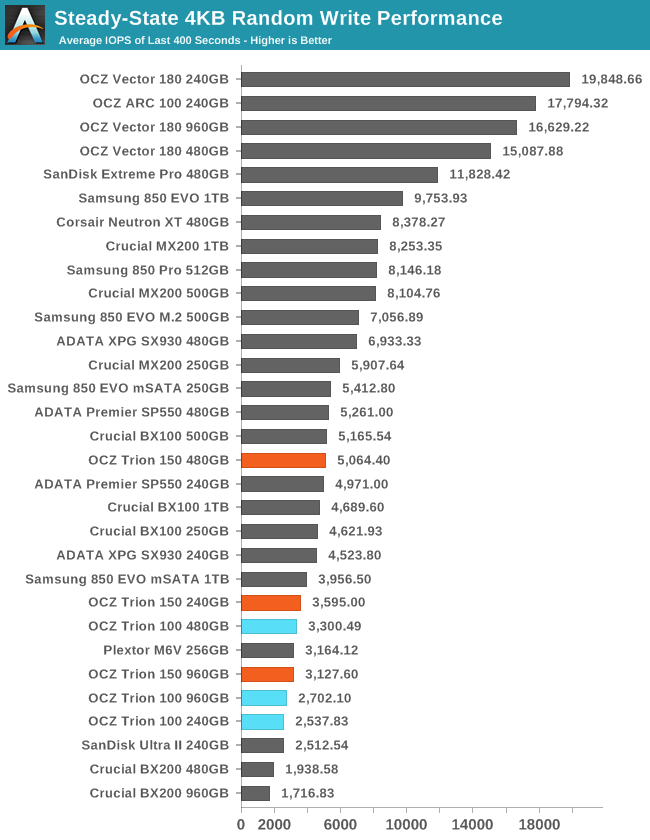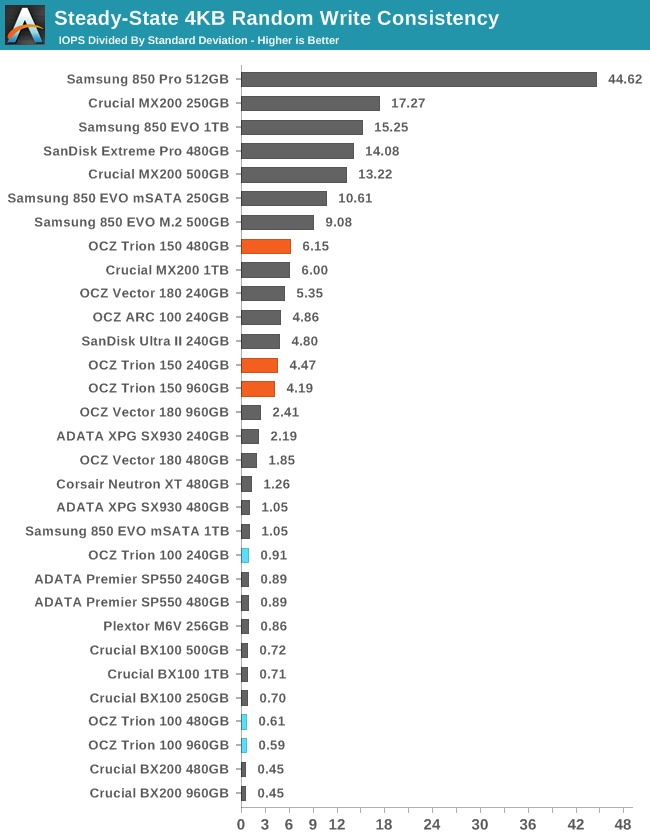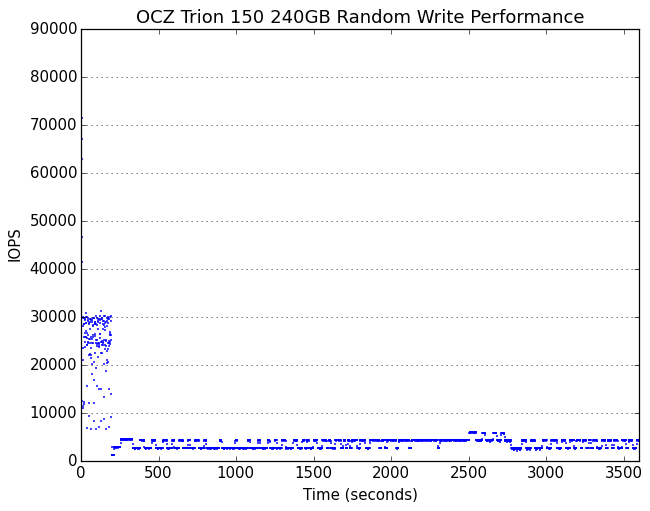The OCZ Trion 150 SSD Review
by Billy Tallis on April 1, 2016 8:00 AM ESTPerformance Consistency
Our performance consistency test explores the extent to which a drive can reliably sustain performance during a long-duration random write test. Specifications for consumer drives typically list peak performance numbers only attainable in ideal conditions. The performance in a worst-case scenario can be drastically different as over the course of a long test drives can run out of spare area, have to start performing garbage collection, and sometimes even reach power or thermal limits.
In addition to an overall decline in performance, a long test can show patterns in how performance varies on shorter timescales. Some drives will exhibit very little variance in performance from second to second, while others will show massive drops in performance during each garbage collection cycle but otherwise maintain good performance, and others show constantly wide variance. If a drive periodically slows to hard drive levels of performance, it may feel slow to use even if its overall average performance is very high.
To maximally stress the drive's controller and force it to perform garbage collection and wear leveling, this test conducts 4kB random writes with a queue depth of 32. The drive is filled before the start of the test, and the test duration is one hour. Any spare area will be exhausted early in the test and by the end of the hour even the largest drives with the most overprovisioning will have reached a steady state. We use the last 400 seconds of the test to score the drive both on steady-state average writes per second and on its performance divided by the standard deviation.

The Trion 150 substantially improves steady-state performance over its predecessor. The middle 480GB capacity is once again the best-performing size by a wide margin.

The Trion 150's consistency score has climbed out of the gutter—aided somewhat by the improved average performance, but there's clearly been a major change in behavior for the drive firmware that reduces the variability of write performance. The Trion 150 scores much better than any other budget drive.
 |
|||||||||
| Default | |||||||||
| 25% Over-Provisioning | |||||||||
After a very short initial burst of high performance due to SLC write caching, the Trion 150 settles into a pattern of decent but broadly variable performance as it burns through the remaining spare area. Once the spare area is exhausted the behavior changes completely and the drive is very steady, transitioning between a handful of discrete performance levels.
 |
|||||||||
| Default | |||||||||
| 25% Over-Provisioning | |||||||||
Looking closer at the steady-state phase, the transitions between performance states are very clear and abrupt, and there are no outliers in either direction. The performance with manual overprovisioning is substantially higher and the consistency is only slightly worse. In either case, the consistency is as good as we could ask for and a big improvement over the earlier Trion 100.










79 Comments
View All Comments
ocztaec - Tuesday, April 5, 2016 - link
Hi Arnulf,As this is my first post on this article please allow me to identify myself as a Toshiba America Electronic Components (TAEC) representative. We completely understand the quality concerns and appreciate your comments. Since the Toshiba acquisition of OCZ in 2014 improving product reliability is a key priority for us. We made significant changes to everything from processes to production. OCZ SSDs are made with premium Toshiba NAND and is back by the Advanced Warranty Program.
We understand how you feel and hope that one day we will have the opportunity to demonstrate the reliability of current OCZ products. Thank you again for your feedback.
nathanddrews - Friday, April 1, 2016 - link
Not a great showing, that's for sure. I'd like to point out two things - one is that we're looking at a range of drives that could be offering 2TB SSDs for under $400. WhereTF are they? I feel like we've been pretty patient, but at these prices, I can actually afford to replace all disks on my PCs and getting really close to replacing disks on my servers and NAS units.Second, would it be at all reasonable to add a WD VelociRaptor, Hybrid SSHD, and/or common 5400RPM hard drive to the 2015 SSD Bench like the old days? I think most of the readership knows how much better ANY SSD is over a mechanical HDD, but I think we also get a bit too cynical with drives like this that are "slow" compared to other SSDs and won't even consider buying them. We shouldn't forget where we came from. XD
tarqsharq - Friday, April 1, 2016 - link
I second this, really want to keep perspective on speeds, especially when we're dealing with the low cost SSDs where you can get high storage space for low $$ImSpartacus - Saturday, April 2, 2016 - link
Yeah, it would a fantastic way to gain context. Just don't worry about scaling the graphs for the hard drives if that ever becomes an issue.bug77 - Friday, April 1, 2016 - link
Have you seen the size increase of the PCB? There's no space for 2TB worth of chips.DanNeely - Friday, April 1, 2016 - link
Agreed, as stated in the 2nd paragraph of the article: "It's important to keep in mind that for the cheapest SSDs on the market, maximizing performance is not the only goal and often isn't even a primary goal." Yes, the performance sucks compared to anything the average Anandtech reader would put in his computer, but these drives are intended to get people who buy cheap crappy computers at the boxmark off of spinning rust. It might help if the performance charts were split between performance and budget SSDs, otherwise is as unfair as comparing a standard HDD to a 15k SAS drive would've been a dozen years ago.It's still probably 2 or 3 generations before I'd consider SSDing my NAS. Pricing even on cheap SSDs is still ~6x that of NAS HDDs; it'd need to drop to at most 2x before I'd consider it; at that point reduced power consumption over a half dozen years might be able to close enough of the gap that quieter operation and smaller size might be worth the larger up front cost. Also, I'd want at least 6gb of post RAID storage capacity if standing up a new NAS today; probably 10 or 12 if I'd be filling all the bays and unable to add more storage to it later; with my needs growing by about 2x every 3-4 years. The smaller criteria could be met by 4x2gb drives in raid 5; the latter would either need 4gb drives or an 8 bay enclosure. Pre-built 8-bay NASes suffer from an additional enterprise price premium; while on the DIY front that many sata ports is stretching what can be done with cheap hardware and I'm not aware of any mITX sized cases with that many drive bays.
bji - Friday, April 1, 2016 - link
Just curious, what do you do with all that storage? 10 to 12 TB (I assume your 6gb was a typo and you meant 6tb) is a hell of alot of storage. What do you need so much storage for?I am still using a first gen Macbook pro retina with 256 GB of SSD storage and I have 90 GB free. Even my server that does backups and stuff uses only about 350 GB.
DanNeely - Friday, April 1, 2016 - link
Media and system backups. About half of the latter is images of old systems that I got rid of at some point. Feeding bigger drives into the nas is a lot easier than trying to scour a system to make sure everything of value's been removed separately. Most recently some scanned documents a family member left in the scanner apps temp folder (that I didn't even know existed).bji - Friday, April 1, 2016 - link
What kind of media needs that much storage? Are you a professional videographer?Arnulf - Saturday, April 2, 2016 - link
P0rn :)